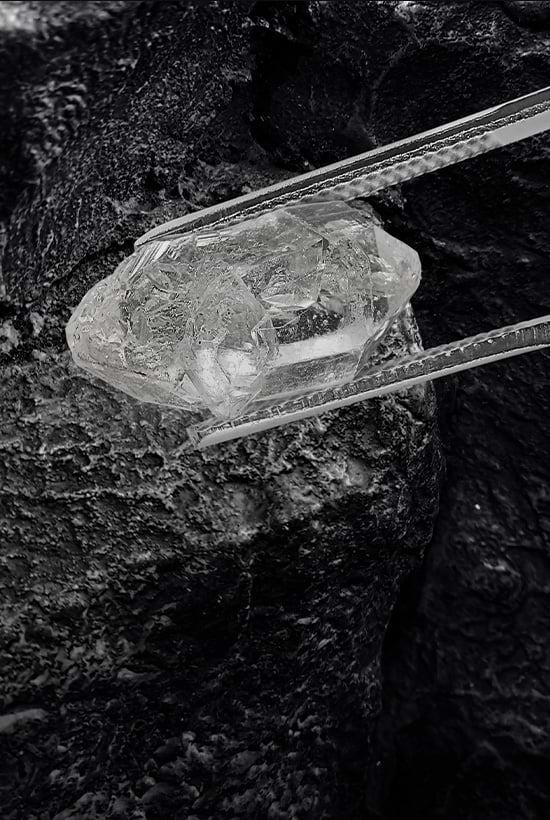WHAT IS A NATURAL DIAMOND


A natural diamond is a diamond that has formed deep below the earth’s surface over billions of years under specific environmental conditions, namely, extreme pressure and temperature. These diamonds begin as carbon deposits that are slowly bonded together to form a crystal lattice structure that will ultimately become a diamond. Natural diamonds are typically formed in the mantle of the earth at depths of 140 to 190 kilometers, and are brought to the earth’s surface through volcanic eruptions or other geological processes.
The formation of natural diamonds requires the extreme environmental conditions mentioned above, as well as, the presence of carbon-rich materials such as kimberlite, lamproite, or eclogite rocks. Natural diamonds can vary in size, shape, and color depending on the specific geological conditions that formed them.
Natural diamonds are composed of pure carbon and are the hardest known substance on Earth. They have a unique crystal structure that gives them their distinctive optical and physical properties, such as their high refractive index and ability to scatter light.
Natural diamonds are valued for a variety of reasons including, rarity, beauty, durability, and sentimentality.
Anatomy of a Natural Diamond
All diamonds share certain structural features that help determine its proportion, brilliance, dispersion, and scintillation. Understanding the anatomy of a diamond and knowing the individual features that comprise the whole, will arm you with the information you need when choosing your perfect diamond.
There are seven main components of a diamond:
- Diameter: This is the width of a polished stone as measured from edge to edge.
- Table: The table is the largest polished facet located at the top of the diamond.
- Crown: The crown is the top part of the diamond that extends from table to girdle.
- Girdle: The widest part of the diamond, the girdle refers to the intersection of the crown and the pavilion which defines the perimeter, or outermost edge, of the diamond.
- Pavilion: The pavilion is the bottom portion of the diamond, extending from girdle to cutlet.
- Cutlet: The cutlet is a facet cut at the very tip of the bottom of the diamond. This is meant to help protect the diamond from splitting and keeps the fragile tip from being chipped.
Conflict Diamonds
Conflict diamonds, also known as blood diamonds, are diamonds that are mined and sold to finance armed conflict against governments. These diamonds are typically mined in war zones and sold to fund rebel groups or other armed organizations that are fighting against legitimate governments. The sale of conflict diamonds has been linked to human rights abuses including forced labor, child labor, and violence against miners and local communities.
Conflict-Free Diamonds
Over the past fifteen years, the international diamond industry has taken steps to combat the trade in conflict diamonds and secure mining and selling processes where diamonds are extricated from these conflict ridden channels and are sourced completely conflict-free. The establishment of the Kimberley Process, a certification scheme which tracks diamonds from mine to sale, aims to ensure that diamonds are sourced ethically by requiring that all rough diamonds are certified as conflict-free before they can be sold.
A natural diamond is a mineral composed of pure carbon that has been formed deep below the earth's surface over billions of years.
Natural diamonds are formed under extreme environmental conditions, specifically, high pressure and high temperature deep within the earth's mantle. They are brought to the surface through volcanic activity.
Natural diamonds are graded using the 4Cs – cut, color, clarity, and carat weight. These are the four essential diamond characteristics that help determine a stone's value and quality.
Though there has been controversy surrounding mining practices, there has also been significant development in ethical and environmental diamond sourcing. For instance, the Kimberley Process was put in place to closely monitor the imports and exports of diamonds to ensure that they are not connected to or used to finance any armed conflict. Additionally, many diamond companies have also implemented policies that guarantee fair labor practices and human rights protections for their workers, promoting ethics and human development.
Though the diamond mining process can have an impact on the environment including deforestation, soil erosion, and water pollution, there has been a significant increase in efforts to protect the environment and promote sustainability. One of those are land restoration programs, which both mitigates the environmental impact of mining and provides long-term benefits for surrounding communities by restoring vegetation and creating habitats in places that had previously been mines.
